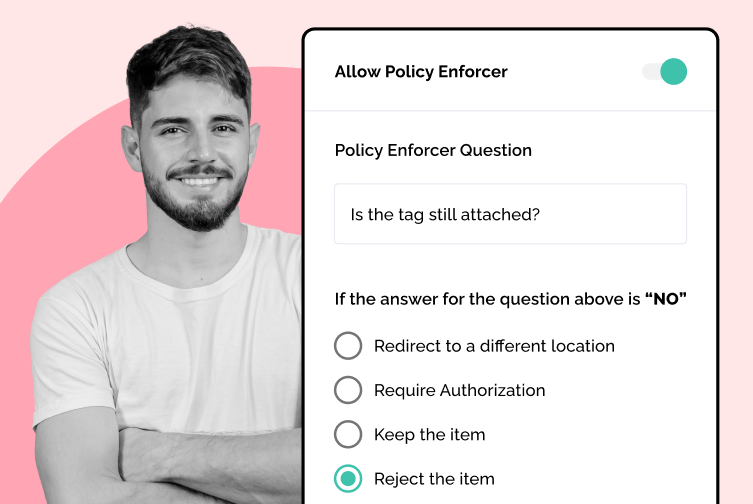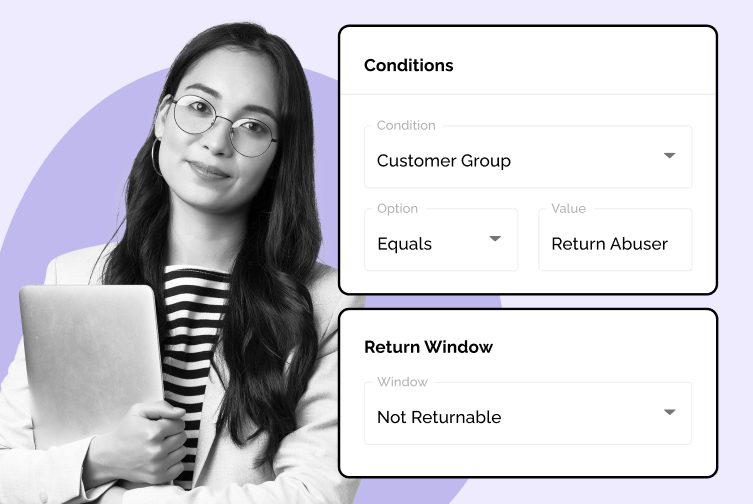
Effective Customer Feedback Analysis Post Purchase: Methods & Insights
Discover effective methods for analyzing customer feedback post-purchase. Enhance satisfaction and drive improvement!
Boost customer experience and reduce support tickets
Realtime order and shipment tracking
Proactive order and shipping notifications
Predictive pre-purchase estimated delivery dates
Self-Serivce branded order tracking
Effortless experience delivered
Make returns profitable and delight customers
Flexibility to define any return destinations & conditions
Simplify returns for your customers and team
Incentivize exchanges over returns
Returns management made easy for your team
Understand why your customers are returning
Unify the online and the in-store experience
Hassle-free pickup experience for customers
In-Store Dashboard to keep operations streamlined
In-Store and Online orders unified
Drive foot-traffic to your stores
Boost customer experience and reduce support tickets
Realtime order and shipment tracking
Proactive order and shipping notifications
AI-Enhanced Discounted Labels
Predictive pre-purchase estimated delivery dates
Self-Serivce branded order tracking
Effortless experience delivered
Make returns profitable and delight customers
Flexibility to define any return destinations & conditions
Simplify returns for your customers and team
Incentivize exchanges over returns
Returns management made easy for your team
Equip your team for precise return checks.
Understand why your customers are returning
Unify the online and the in-store experience
Hassle-free pickup experience for customers
In-Store Dashboard to keep operations streamlined
In-Store and Online orders unified
Drive foot-traffic to your stores
Find the answer to all your questions
Explore the most comon questions about WeSupply
Calculate the ROI that WeSupply can bring you
Request a no strings attached review of your current shopping experience and missed conversion opportunities
Take a step by step trip through our functionality to see how we can improve your ecommerce processes.
Read actionable articles on how to optimize your post-purchase experience and decrease support tickets
Get inspired by stories of how our customers implemented an effortless post-purchase experience
A Deep Dive into Top Companies' Order Tracking & Returns Strategy
Wondering if WeSupply is a good fit for you? Read through our use cases to see how we can help you increase conversion & improve CX!

For online retailers, returns are the elephant in the room. You work hard to attract a customer, convince them to buy, and deliver the product only for it to come back a week later. This isn’t just disappointing; it’s expensive. Managing returns is a critical challenge for any retail business. Each return chips away at your margins through lost revenue, reverse logistics costs, restocking expenses, and potential inventory depreciation. Return costs are a significant factor impacting profitability.
The truth is, high return rates can undermine even the fastest-growing e-commerce business. In some categories, like fashion, return rates can exceed 30%. Without a clear understanding of why returns happen, you risk repeating the same mistakes over and over leading to profit leakage and frustrated customers. High return rates can also result in customer dissatisfaction and erode loyalty.
Analyzing returns data flips the script. By digging into the patterns and reasons behind returns and leveraging historical data to identify trends, you can identify root causes, correct underlying issues, and make smarter business decisions. With the right approach, returns go from being a costly headache to a goldmine of insights for improving product quality, enhancing customer satisfaction, and boosting profitability.
Before diving into spreadsheets and dashboards, you need to understand that every return is essentially a piece of feedback from a customer. It’s their way of saying, “Something about this purchase didn’t meet my expectations.”
Common drivers include:
Buyer’s remorse — The customer changes their mind after purchase.
Unmet expectations — The product didn’t look, fit, or perform as described.
Quality issues — Defects, damage, or poor craftsmanship.
Delivery delays — Late arrivals reducing the product’s usefulness (e.g., missed event deadlines).
By analyzing customer demographics, purchase history, and return patterns, you can identify high-risk customer segments. For example, new customers might return items more often than loyal ones, or certain age groups might have specific preferences that aren’t being met.
Customer feedback is a goldmine here. Reviews, survey responses, and even social media comments can reveal recurring pain points. If customers frequently mention that shoes “run small,” that’s a clear sign your sizing guide or product design needs attention. Identifying recurring issues in feedback allows you to address root causes and prevent future returns. Providing better customer support can also help address issues like buyer’s remorse and reduce returns.
This is where predictive modeling comes into play. By feeding historical return data into machine learning algorithms, you can forecast future returns, spot early warning signs, and take preventive action before the next batch of returns rolls in. Predictive models can also help you analyze different customer segments, enabling proactive customer support to anticipate and resolve issues before they lead to returns.
You can’t fix what you can’t measure. That’s why building a strong foundation of accurate, detailed returns data is non-negotiable. Analyzing the data collected is essential to ensure you have the right data for effective returns analysis and better decision-making.
Key data points to collect include:
Return reason — Use a standardized list, such as “too small,” “damaged in transit,” “not as described,” or “wrong item sent.”
Product details — SKU, category, size, color, and any relevant attributes.
Product category — Track which product category each return belongs to for more granular analysis.
Customer information — Purchase history, demographics, and whether they’ve returned items before.
Order details — Purchase date, return date, sales channel (online vs. in-store).
Costs — Shipping fees, restocking costs, and potential loss in resale value.
Contextual data makes your analysis richer. Linking returns to specific seasons, regions, or production batches and analyzing trends over a specific period can uncover seasonal or time-based patterns you’d otherwise miss. For example, if a spike in returns coincides with a particular supplier’s batch, you’ve just identified a quality control issue.
Returns management software is invaluable here. Tools like WeSupply or ReverseLogix can automate data capture across platforms, ensuring consistency and reducing manual errors.
Even the most detailed dataset is useless if it’s messy. Dirty data duplicates, inconsistent return reasons, missing fields can distort your insights and lead to bad decisions.
Start by standardizing your categories. Merge similar return reasons (e.g., “too small” and “size issue”) into one category for cleaner analysis. Remove duplicates, and fill in missing information where possible. Accurate returns analysis depends on clean, standardized data, as it ensures that the reasons for returns are correctly categorized and errors are minimized.
Integration is equally important. Pull returns data from your e-commerce platform, CRM, warehouse management system, and customer support channels into a centralized database. This creates a single source of truth, eliminating conflicting numbers between departments.
The result? You can confidently say, “Yes, this category has a 28% return rate, and here’s exactly why.”
With clean, organized data, you can move into the fun part uncovering patterns and pinpointing root causes. Using descriptive analytics helps you understand historical return patterns and trends, providing a foundation for performance improvement and benchmarking.
Root cause analysis is about identifying root causes. If “too small” is the top return reason for a single dress model, the issue might be that its sizing chart is misleading. If multiple products share the same issue, it might be a brand-wide sizing standard problem.
Segmentation can reveal even more. Maybe certain customer segments, like those in colder climates, return summer dresses at higher rates because the style doesn’t match their lifestyle.
Visualizing your findings in dashboards makes it easier to communicate across teams. These visualizations provide actionable insights, helping teams quickly identify key trends and metrics to improve returns management. A clear chart showing the top five return reasons by category can rally product design, marketing, and logistics around the same priorities.
Returns Analytics for eCommerce Business
Book a quick call with our experts to see how WeSupply can help you understand why your customers are returning: Identify the most returned products, Understand why those products are returned, Identify which customers are serial returners, Reduce Return Rate with Actionable Insights, Returns data available in BigQuery.
Manual analysis has its limits especially if you’re processing thousands of returns each month. That’s where technology steps in.
AI-driven analytics platforms can:
Identify subtle patterns humans might overlook.
Forecast return spikes based on historical trends and market variables.
Detect potential fraud or policy abuse.
Build predictive models to identify potential return risks early and help address them proactively.
For example, sentiment analysis tools can scan thousands of customer reviews and flag recurring negative phrases tied to specific products. Predictive analytics can warn you that a certain SKU is likely to see a 15% return spike next quarter giving you time to adjust stock or fix the product description.
Popular tools include WeSupply for predictive insights, operational dashboards. Leveraging these technologies can ultimately lead to fewer returns and improved profitability.
Optimizing your supply chain is a powerful lever for reducing return rates and boosting customer satisfaction in e-commerce. By closely analyzing returns data, online retailers can pinpoint weak spots in their reverse logistics process—whether it’s inconsistent quality control, inefficient shipping, or inadequate packaging. Addressing these issues not only cuts down on costly returns but also enhances the overall customer experience, leading to greater customer loyalty.
Leveraging predictive analytics and machine learning models, retailers can forecast return patterns and proactively identify areas in the supply chain that need improvement. For example, if returns data reveals a spike in damaged goods from a particular warehouse, it signals a need for better packaging or handling protocols. Implementing robust returns management software further streamlines the process, making it easier to track and manage returns across multiple channels.
Optimizing inventory management is another key benefit. By integrating returns data with supply chain operations, retailers can maintain optimal stock levels, reduce waste, and improve operational efficiency. Ultimately, a data-driven approach to supply chain management not only minimizes returns but also strengthens your brand’s reputation for reliability and high customer satisfaction.
Once you know the why, you can fix the what. Here’s how data turns into action. Targeted strategies not only reduce returns but also increase customer satisfaction:
Sizing & Fit Issues — Introduce more accurate size charts, virtual try-on technology, and customer review fit data.
Product Descriptions — Upgrade listings with precise specs, high-quality images, videos, and even 360° views.
Quality Control — Work with manufacturers to address defects and improve packaging to prevent damage during transit.
Fulfillment Accuracy — Streamline warehouse processes and invest in barcode scanning to reduce wrong-item shipments.
Fraud Prevention — Use AI to flag suspicious return patterns and adjust return policies accordingly, helping control return costs.
Expectation Management — Send pre-delivery emails with care instructions, usage tips, or realistic previews to manage expectations and minimize unnecessary return costs.
Return Policy Adjustments — Evaluate whether to offer free returns or limit them. Adjusting free returns policies can impact both customer satisfaction and return costs; for example, some retailers now charge for returns to reduce expenses, while others maintain free returns to increase customer satisfaction.
Every change should be measurable. If you introduce a new size guide, track the category’s return rate over the next quarter to confirm its effectiveness.
Personalization isn’t just a marketing buzzword it’s a powerful tool for reducing returns.
Personalization can directly address customer dissatisfaction and help reduce higher return rates, especially in categories like apparel and electronics, by ensuring customers receive products that better fit their needs and expectations.
Using purchase history and browsing data, you can recommend products that are a better match for each customer’s preferences. If someone always buys in a specific size or style, highlight those options in future recommendations.
Proactive engagement works wonders, too. A simple live chat widget or Q&A section can answer sizing or material questions before purchase, preventing mismatches later.
Offering exchanges instead of refunds can also preserve the sale while solving the customer’s problem. Sweeten the deal with loyalty points or small discounts for choosing an exchange.
To truly harness the power of returns data, e-commerce businesses should adopt a set of best practices that ensure both accuracy and actionable outcomes. Start by collecting comprehensive key data points such as product details, return reasons, customer demographics, and purchase history to build a rich dataset for analysis. This foundation allows you to spot trends and patterns that might otherwise go unnoticed.
Utilize statistical analysis and diagnostic analytics to dig deeper into the data, uncovering the root causes behind returns. Advanced analytics, including predictive analytics and sentiment analysis, can provide valuable insights into customer behavior and preferences, helping you anticipate future return trends and tailor your strategies accordingly.
Consistency is crucial. Use technology to standardize your data collection and analysis processes, ensuring that insights are reliable and comparable over time. Most importantly, translate these insights into actionable strategies whether it’s refining product descriptions, improving quality control, or personalizing the customer experience to enhance customer satisfaction and reduce return rates. By following these best practices, you’ll turn returns data into a powerful tool for continuous improvement and business growth.
While the benefits of returns data analysis are clear, e-commerce businesses often encounter several common challenges along the way. Data quality issues such as incomplete, inconsistent, or inaccurate data can undermine your analysis and lead to misguided decisions. Additionally, limited resources, whether in terms of technology or skilled personnel, can make it difficult to conduct thorough and timely analyses.
Identifying the root causes of returns is another complex hurdle. It requires a nuanced understanding of customer behavior, product features, and operational workflows. Without the right tools and expertise, it’s easy to misinterpret the data or overlook important details.
To overcome these obstacles, invest in robust data collection and analysis tools that ensure high-quality, reliable data. Provide ongoing training for your team to build analytical skills and foster a culture of continuous improvement. By addressing these challenges head-on, you’ll be better equipped to identify root causes, optimize your returns process, and make informed decisions that drive your e-commerce business forward.
Reducing returns isn’t a one-and-done project. Customer expectations, market trends, and even product lines evolve and so should your analysis. Continuous monitoring not only helps you adapt to these changes but also enables you to anticipate and reduce future returns by identifying patterns and refining your approach as needed.
Set benchmarks and KPIs, like return rate targets by category or improvements in specific return reasons. Review these regularly and share them across teams.
Encourage collaboration between product design, marketing, logistics, and customer service. Each department sees the customer journey from a different angle, and their input can uncover solutions you might miss.
Finally, remember the sustainability angle. Every avoided return means less waste and fewer carbon emissions from reverse logistics a win for both your margins and your brand reputation.
Reducing eCommerce return rates starts with understanding exactly why customers are returning and that’s where WeSupply’s Returns Analytics delivers game-changing insights. With our platform, you’ll move beyond guesswork to data-driven decisions that protect profits, improve products, and boost customer loyalty.
Key WeSupply Features for Smarter Returns Analysis:
Customer Insights – Identify serial returners, analyze returns by region, and understand how return behavior impacts lifetime value.
Financial Impact Tracking – Measure revenue lost to returns, calculate costs, and uncover ways to increase profitability.
Actionable Data Access – Integrate with BigQuery, monitor return status in real time, and forecast daily return volumes for operational efficiency.
Customer Feedback Collection – Gather proof, avoid fraud, and capture product fit or quality concerns to inform product improvements.
Exchange Incentives – Offer instant credit or exchange options to retain revenue and reduce refund requests.
Branded Self-Service Portal – Give customers a seamless, on-brand returns experience that strengthens trust and reduces support calls.
Integration with Powerful Review Platforms – Turn authentic customer reviews into conversion powerhouses with direct integrations:
Loox – Showcase visual-centric reviews and referrals to build trust.
Judge.me – Automate review collection via web, email, push, and SMS.
Stamped – Gather ratings, reviews, referrals, and run loyalty programs.
Yotpo – Collect reviews, launch referrals, and grow recurring sales with SMS and subscriptions.
Okendo – Capture and display high-impact user-generated content on your site.
Junip – Gather reviews from multiple channels and publish them in minutes.
Reviews.io – Collect genuine text and video reviews quickly and display them for maximum impact.
With WeSupply, you’re not just tracking returns you’re transforming them into opportunities for growth, better customer experiences, and a healthier bottom line. See Your Returns in a Whole New Way, Book Your WeSupply Demo Today!
The future of returns data analysis lies in combining advanced technology with actionable insights and WeSupply is leading the way. With SKU-level analytics, BigQuery integration, and real-time return status tracking, retailers can pinpoint return reasons, measure financial impact, and forecast daily volumes.
Customer insights help identify serial returners, analyze returns by region, and understand lifetime value, while built-in feedback collection prevents fraud and drives product improvements. Seamless integrations with review platforms like Loox, Judge.me, Stamped, Yotpo, Okendo, Junip, and Reviews.io transform authentic customer feedback into sales power. Branded self-service portals streamline the process, and instant credit incentives turn refunds into exchanges.
By leveraging these tools, retailers not only reduce return rates but also boost profits, strengthen loyalty, and set new standards for customer experience in an evolving eCommerce landscape.
Combat inconvenience with proactivity & self service
Book a quick call with our experts to see how WeSupply can help you make returns easy for your customers with a beautiful, self-service solution that makes their experience easier while also providing new ways to lower costs and earn back revenue.
Keep your customers engaged during the delivery experience
Book a quick call with our experts to see how WeSupply can help you engage your customers with relevant updates through the right channel, at the right time.
1. What is returns data analysis in eCommerce?
Returns data analysis involves studying return reasons, customer behavior, and product details to identify trends, fix root causes, improve product quality, and reduce future return rates.
2. How can analyzing returns data reduce return rates?
By identifying patterns in return reasons and customer segments, businesses can make targeted improvements to product descriptions, sizing charts, quality control, and fulfillment accuracy.
3. Which data points are most important for returns analysis?
Key data includes return reason, SKU, product category, customer demographics, purchase history, order details, and costs associated with each return.
4. How does WeSupply help reduce eCommerce return rates?
WeSupply’s SKU-level analytics, real-time tracking, and customer feedback tools pinpoint root causes of returns, enabling data-driven product, policy, and fulfillment improvements.
5. What integrations does WeSupply offer for returns management?
WeSupply integrates with platforms like Loox, Judge.me, Yotpo, Stamped, Okendo, Junip, and Reviews.io to collect and showcase customer reviews that boost conversions and reduce returns.
6. Can WeSupply forecast future return volumes?
Yes. WeSupply’s predictive analytics and BigQuery integration forecast daily return volumes, helping retailers prepare inventory, staffing, and logistics to minimize operational costs.
7. Does WeSupply have an Official Shopify App?
Yes. WeSupply has an Official Shopify App. You can download it and start integrating with your Shopify Store.
8. Does WeSupply have an official Magento extension?
Yes, WeSupply has an official extension for Magento. The WeSupply x Magento integration allows for automating order tracking experiences, reducing customer inquiries, automating shipping email and SMS notifications, and providing a fully branded order tracking experience
9. Does WeSupply have an official BigCommerce App?
Yes, WeSupply has an official BigCommerce App. You can integrate WeSupply with your BigCommerce store to improve your post-purchase customer experience.
Learn How To Create Successful Post Purchase Email Campaigns
Build an effective post-purchase email flow that helps you increase customer satisfaction and drive revenue growth!

Discover effective methods for analyzing customer feedback post-purchase. Enhance satisfaction and drive improvement!

Learn effective strategies to combat wardrobing and tag switching in fashion ecommerce. Protect your business and enhance customer trust. Read more now!

Learn how to manage BOGO returns effectively while ensuring customers aren’t charged for the free item. Practical solutions!

Explore how automation and data can enhance your shipping strategy. Discover best practices to stay competitive and efficient. Read the article now!

Discover effective strategies to prevent return promo abuse with smart logic. Enhance your business’s integrity!

Learn how to effectively manage promo bundle returns while protecting your revenue. Discover practical tips to streamline your process!

Learn how to manage BOGO returns effectively while ensuring customers aren’t charged for the free item. Practical solutions!

Explore how automation and data can enhance your shipping strategy. Discover best practices to stay competitive and efficient. Read the article now!

Discover effective strategies to prevent return promo abuse with smart logic. Enhance your business’s integrity!